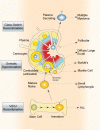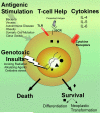Genetic susceptibility to lymphoma
- PMID: 17606447
- PMCID: PMC2819165
- DOI: 10.3324/haematol.11011
Genetic susceptibility to lymphoma
Abstract
Genetic susceptibility studies of lymphoma may serve to identify at risk populations and clarify important disease mechanisms. This review considered all studies published through October 2006 on the contribution of genetic polymorphisms in the risk of lymphoma. Numerous studies implicate the role of genetic variants that promote B-cell survival and growth with increased risk of lymphoma. Several reports including a large pooled study by InterLymph, an international consortium of non-Hodgkin lymphoma (NHL) case-control studies, found positive associations between variant alleles in TNF -308G>A and IL10 -3575T>A genes and risk of diffuse large B-cell lymphoma. Four studies reported positive associations between a GSTT1 deletion and risk of Hodgkin and non-Hodgkin lymphoma. Genetic studies of folate-metabolizing genes implicate folate in NHL risk, but further studies that include folate and alcohol intakes are needed. Links between NHL and genes involved in energy regulation and hormone production and metabolism may provide insights into novel mechanisms implicating neuro- and endocrine-immune cross-talk with lymphomagenesis. However, this links will need replication in larger populations. Numerous studies suggest that common genetic variants with low penetrance influence lymphoma risk, though replication studies will be needed to eliminate false positive associations.
Figures





References
-
- Harris NL, Jaffe ES, Diebold J, Flandrin G, Muller-Hermelink HK, Vardiman J, et al. The World Health Organization classification of neoplasms of the hematopoietic and lymphoid tissues: report of the Clinical Advisory Committee meeting--Airlie House, Virginia, November, 1997. Hematol J. 2000;1(1):53–66. - PubMed
-
- Segel GB, Lichtman MA. Familial (inherited) leukemia, lymphoma, and myeloma: an overview. Blood Cells Mol Dis. 2004 Jan;32(1):246–61. - PubMed
-
- Linet MS, Pottern LM. Familial aggregation of hematopoietic malignancies and risk of non-Hodgkin's lymphoma. Cancer Res. 1992 Oct 1;52(19 Suppl):5468s–73s. - PubMed
-
- Houlston RS, Catovsky D, Yuille MR. Genetic susceptibility to chronic lymphocytic leukemia. Leukemia. 2002 Jun;16(6):1008–14. - PubMed
-
- Goldin LR, Pfeiffer RM, Li X, Hemminki K. Familial risk of lymphoproliferative tumors in families of patients with chronic lymphocytic leukemia: results from the Swedish Family-Cancer Database. Blood. 2004 Sep 15;104(6):1850–4. - PubMed
Publication types
MeSH terms
Grants and funding
LinkOut - more resources
Full Text Sources
Other Literature Sources
Medical

